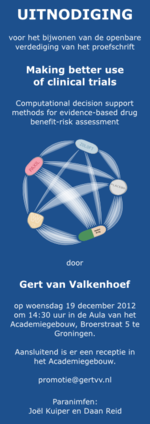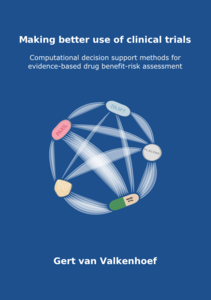
My PhD research at the Department of Epidemiology, University Medical Center Groningen and at the Faculty of Economics and Business, University of Groningen started in April 2009 and culminated in the defense of my PhD thesis
on 19 December 2012 (cum laude / with honor — a distinction awarded to only 6% of theses in the Medical Sciences). This thesis was produced in the context of the Escher Project (T6-202), a project of the Dutch Top Institute Pharma. The Escher Project brings together university and pharmaceutical partners with the aim of energizing pharmaceutical R & D by identifying, evaluating, and removing regulatory and methodological barriers in order to bring efficacious and safe medicines to patients in an efficient and timely fashion. The project focuses on delivering evidence and credibility for regulatory reform and policy recommendations.
My activities and responsibilities during the project included the following:

Get the free PDF and the propositions (stellingen)
Buy from amazon.com | amazon.co.uk | amazon.de | amazon.fr
Health care policy decision makers routinely evaluate the health impact of alternative treatment options. Here benefit-risk assessment is key, consisting of weighing the favorable effects (benefits) and unfavorable effects (risks) of the alternatives. For example, before a new drug is allowed on the market, regulators evaluate its benefit-risk balance in comparison to placebo or competing drugs.
Ideally, benefit-risk assessments are based on the best available evidence, typically meaning randomized controlled trials. However, finding the evidence and explicitly linking it to the assessment is complicated by several factors. First, the results of clinical trials are mainly made available in text-based documents that can not be processed automatically. Second, the data from these trials must be combined into a consistent basis for benefit-risk analysis. Third, quantitative decision models are required to directly link decisions to the underlying evidence and to make trade-off decisions explicit.
This thesis addresses these topics through the development of the Aggregate Data Drug Information System (ADDIS), an integrated system for decision support based on databases of structured clinical trials data. Novel algorithms are presented to automate network meta-analysis to combine clinical trials' results and multi-criteria decision models are developed to support benefit-risk assessment.
ADDIS is open source software, available from http://drugis.org/.